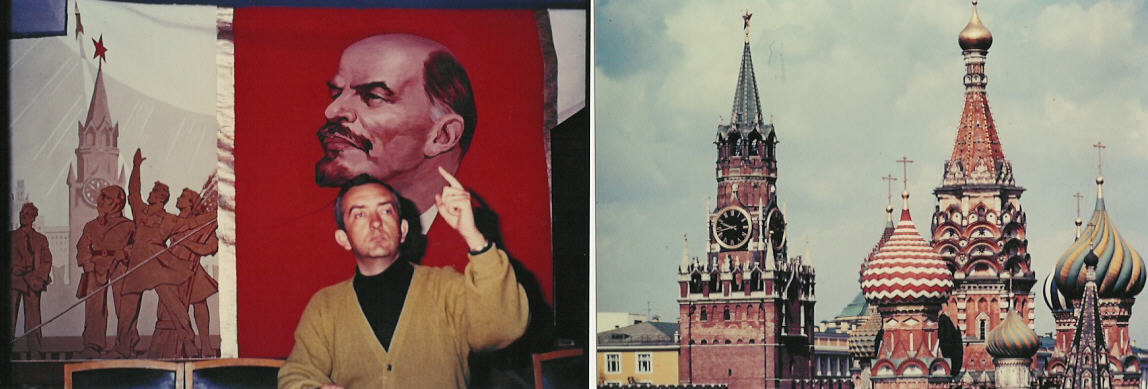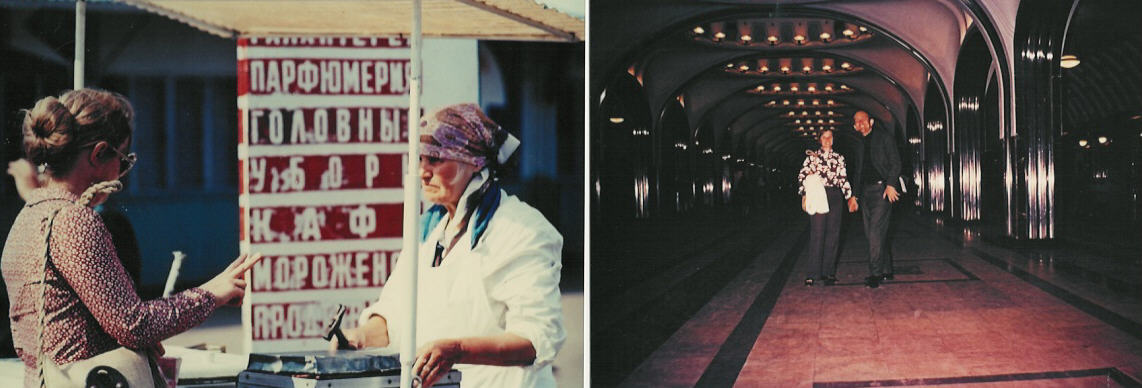
Russia ( 1971)
A
Russian Sampler It all started on the afternoon of June 7 when two Ilyushin 62’s flew into the Milan airport to pick us up. Valerie and I, two other American couples and some three hundred Italians from the 3M Italian subsidiary Ferrania touring club filled both planes to capacity. The flight was comfortable and in three and a half hours we were landed in Moscow. |
Addressing the Party The Spires of Red Square
Moscow. Buses were at the airport to meet us and take us to our hotel . . . the Hotel Rossia, a 3200 room newly constructed and modern hotel and the largest in Europe. It is located on the banks of the Moscow River and right off of Red Square. In fact, from our balcony, we could look down into the Kremlin walls.
We had a special "welcome" dinner the first night . . . caviar, vodka and the rest . . . and after dinner took a midnight stroll over to Red Square to watch the hourly changing of the guard at Lenin’s tomb. I have frequently asked myself in our various travels, ‘What am I doing here?’ . . . but I don’t think I’ve ever felt such an overwhelming sense of awe and wonderment as I did standing with Val in the moonlight-flooded Red Square that first night in Moscow.
The main ‘sight’ of the city is, of course, the Kremlin. Inside the walls are not only the government buildings but three magnificent cathedrals and a couple of lesser ones. The tombs of the czars are there . . . from Ivan the Terrible up to, but not including, Peter the Great (who moved the capital to Leningrad. . . then Petrograd . . . and is, therefore, buried there). The royal treasury is also inside the Kremlin walls but it wasn’t on display when we were there.
Just outside the walls is Lenin’s tomb, facing Red Square. They have an ‘express’ line for foreigners to file through the tomb . . . so our wait was only a little over a half hour. The Russian citizens, however, wait for up to eight ours to file through. For us, seeing Lenin’s body was little more than a curiosity . . but for the Russians it takes on the almost religious tones of a pilgrimage.
After leaving the tomb you walk along the wall past a number of graves of lesser importance including that of Stalin, which is reasonable prominent, and the tombstone marked with his bust. In the wall itself, others are buried in chronological order of their death dates . . . the second to last was Yuri Gagarin (1934-1969). As of yesterday, there will be three more . . . the three Russian astronauts, who lost their lives in an unsuccessful re-entry from earth orbit. (Incidentally, the Soyuz flight was in its first week while we were there and, of course, was headlined in both the newspapers and on television)
 |
Ice Cream Vendor Moscow Subway Station
We tried out the subway system which is a tourist attraction in itself. It has over 90 stations and most are like art galleries with frescoed ceiling and crystal chandeliers. You got down into the subway in seemingly endless escalators to a depth of over 200 feet. Apparently the builders had air raid defense, at least partly in mind, in going down to such great depths underground. Actually Moscow was relatively untouched by World War II, even though the German army got to within twenty miles of the city before things got bogged down at Stalingrad.
Nobody in Russia has forgotten the German invasion . . and in that light it’s not hard to understand their obsession with ABM systems . . and for that matter it’s quite understandable why they find a bugger zone of satellite states between themselves and the Germans quite convenient.
The life of an average Russian appears to be quite grim. It’s particularly evident in the big, state-run GUM department store. The place is as big as Marshall Fields in Chicago but the variety and the quality of the goods which are offered for sale there are pathetically low . . . just as the prices are frightfully high.
We spent a lot of time just wandering around the city looking in stores and observing the people. There’s absolutely no problems or restrictions on tourists as to free circulation. If we were under observation in any way (something I would highly doubt), it sure wasn’t noticeable. We felt quite comfortable and at ease with the Russian people, with whom I feel much more akin than to, say, the Turks . . . for that matter the Sicilians here in Italy.
We were in Moscow for two days and nights. On the last evening we went to the ballet (Don Quixote) performed by the Bolshoi Ballet company. The performances are held in the Palace of the Congresses, a large new theater inside the Kremlin walls. It seats six thousand people . . whereas the older Bolshoi Theater building, which is nearby, has only limited space. The ballet was excellent. I was impressed, too, by the audience, which along with the many tourists, included may Russian families of evidently modest means, judging from their clothes. In fact we noticed that fact, too, in art museums where a large part of the spectators were quite obviously working class people.
Leningrad. The flight up to Leningrad took less than an hour. Once again we were impressed with the vastness of Russia. Probably only the U.S. itself has so many miles of wide open spaces. We arrived in Leningrad just before the peak of the White Nights. The sun set at 10:30 pm and was back up again before 4 am, but the fact that it drops only seven degrees below the horizon results in the sky never really getting dark.
Leningrad is a beautiful city. It reminded me a bit of both Stockholm and Copenhagen. Because of the numerous waterways and canals, it’s know as the Venice of the North. Here the reminders of the last war were much more evident than in Moscow with bunkers and tank traps still intact. The 900 day siege of Leningrad resulted in most of the city being destroyed . . . but all of the principal monuments have been reconstructed.
 |
Winter Palace - Leningrad Sumeer Palace - Baltic Coast
The Hermitage Art Museum ranks with Louvre and the Prado in importance. It is located in the Winter Place of the Czar. It has a particularly large collection French impressionists along with many works from the Italian Renaissance. There are even two paintings by Leonardo da Vinci and a statue by Michaelangelo.
We took a bus tour outside the city to Petrohof, the summer home of Peter the Great, situated on the Gulf of Finland. It is a magnificent location and the palace grounds are adorned with hundreds of fountains including a number of water "jokes’ (like the Schonbrunn place in Vienna.) Pete pretty much shares the spotlight though in Leningrad with Lenin himself. Lenin’s home, offices, etc. are a part of the same tour, which takes you to Peter’s home and offices . . and the principal locales of the October revolution are highlighted in the tours.
Comparing the splendor of the Czar’s palace with what was the well-being of the average Russian at the turn of the century, it’s not too hard to understand why the revolution took place. And comparing the life of the average Russian under the Czar with the average Russian today under communism, it’s impossible not to acknowledge the tremendous progress made in the intervening years. One only wonders how much more progress they could have made under a freer society.
Our guide in Leningrad was a little blonde with sparking blue eyes , who could just as easily have passed for a Swede or Norwegian. She is in her last year at the University studying history and her husband graduates this summer in medicine. She was surprisingly knowledgeable about Western literature and had read Hemingway, Faulkner and many others. I was surprised to hear that she had read all four of Solzhenitsyn’s books, since the last three are not published in Russia. She said that typed copies circulate freely among the University students. We gave her a copy of a book Val was reading . . . a biography of Czar Nicholas I . . which she appreciated very much.
Kiev Our third and final city was Kiev, in the heart of the Ukraine. Unfortunately, we had only one day there and it rained all day. Nevertheless, we took a short boat ride up the Dnieper River to get a view of the city from the water.
In the afternoon, we were guests at an Italo-Russian friendship reception. It started off with an exchange of speeches and a little propaganda . . . and finished with a variety show, which included top-notch singers, dancer, jugglers and musicians. The highlight, though, was the speech by a ‘colonel’ in the Russian navy . . . what a personage. She had 12 medals (including the Order of Lenin) across her ample chest . .. and room for at least that many more. She had had the honor of raising the Russian naval flag over the city of Berlin, when it fell to the Russians.
The speech she made was memorable . . . along the theme that when the invaders come, the Russian women stand shoulder-to-shoulder with their men in driving them out. And, although she was a happy grandmother, she was prepared to leave her grand-child’s cradle and return to the battle if duty called. She got a little carried away when she pointed out that not only had they driven out the Nazi invaders from Russia but had also liberated Poland, Hungary, Czechoslovakia and they were prepared to liberate us (Italy) too . . if we needed help! No one took her up on the offer, though.
It would have all seemed the most ridiculous sort of propaganda speech . . except for the fact that she was such a dynamic and overwhelming personality . . .and sincerely believed everything she said. At the end she ignoring his outstretched hand, gave Tom Diana (our senior executive who had give the ‘happy to be here’ speech for the Italian group) an enormous bear hug, which came close to smothering him completely.
Our last Russian meal was in Kiev. I haven’t mentioned the food. It was reasonable good, if a little monotonous. Every meal started with smoked fish or caviar and brown bread, then a soup (usually borscht), the meat (or fish) accompanied by rice and fried potatoes. More often than not the desert was ice cream. The beverage was either tea or beer. Nothing really exceptional but certainly good enough.
We left Kiev Sunday at 10 pm after a very close check by armed guards for stowaways among us. Two hours later we were back at Milan . . . and the next day I was back at work as if it had all never happened. Even now as I write I still find it hard to believe that just a few short weeks ago we were standing in the moonlight in the middle of Red Square.